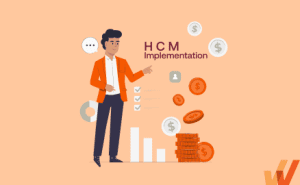
Moving past traditional views of employees as one-dimensional assets, human experience management (HXM) is bringing businesses into a new era of humanizing the way we think about work, workers, and human resources.
A highly engaged team of employees, if empowered to be the best versions of their working selves, will have a more positive employee experiences and enrich the quality of their lives as well as your business.
What is Human Experience Management (HXM)?
Human experience management (HXM) is based on the idea that employees’ human side is what brings value to their work. With this mindset, fostering a safe, healthy, and encouraging environment is the key to improving the work lives of team members while maximizing business outcomes.
Enabling people to feel comfortable and empowered at work reassures them that their humanity comes first. This gives employees the motivation they need to contribute to their work and the company as a whole in a more substantial, authentic way. Today, employees prioritize connection, community, and honesty. Treating people like machines is simply detrimental to all parties involved.
Human Experience Management vs Human Capital Management (HCM)
Human capital management (HCM) is a set of practices used by HR professionals to manage and automate their employee data. This approach is based on the idea that employees are assets like any other. HCM is based on useful and necessary operational data but lacks the human context that employee experience data can bring.
HXM takes parts of traditional HCM that work best and incorporates employee experience data to give a more holistic picture of employee experience. This information gives business leaders the information they need to equip employees with the necessary resources for more positive all-around employee experiences, benefitting the business as a whole.
Human Experience Management vs Employee Experience
Employee experience (EX) is intimately related to HXM. It’s everything an employee feels, encounters, and goes through their employee lifecycle. EX is about empowering employees to reach their full potential in terms of both their personal and professional goals. EX can be improved through careful curation of experience through innovative job design and positive working environments.
Employee experience data is incredibly useful, but ultimately, human experience management is what you need in order to understand how it should be used. HXM compounds the important aspects of EX with personal, human perspectives and with traditional employee management strategies to foster better, evidence-based experiences and ensure success for the organization.

Benefits of Human Experience Management
There are innumerable benefits to human experience management, many of which centre on employee growth and retention. Getting down to the human side of things means cultivating empathy, which 84% of CEOs believe drives better business outcomes and 74% of employees believe increases employee motivation, according to a study by Businessolver.
HXM is all about building a workplace centred on hiring and investing in employees that will grow both as people and with the organization – and be happy about it. Over the course of employee life cycles, these investments end up being incredibly cost-effective, and improving work and life outcomes in every area you can think of – from communication to L&D to client management.
Key Elements of Delivering Human Experience Management
There are several core facets of executing successful HXM strategies. These elements are all tied together and built off one another, combining to provide a foundation for the overall culture and operational structure of a business.
1. Employee wellbeing
Nobody can be expected to be sublimely happy at all times, one goal of an HXM mindset is to keep employees feeling well – this means that they’re comfortable, healthy, and happy at least a majority of the time.
Business leaders and managers can work towards improving employee well-being by providing constant support to their employees and making sure they are comfortable asking for help whenever required.
2. Employee mental health
An aspect that has sadly been neglected in many traditional approaches to people management is preserving and improving mental health. We live in a high-stress world where people are constantly dealing with challenges and struggles that affect their day-to-day lives. People spend a huge portion of their time at work, so employers need to understand that work experience plays a big part in their overall well-being and mental health.
An HXM-centered perspective for employers means focussing on the mental health of employees by eliminating unnecessary workplace stress and embracing different mental health resources like workshops and related benefits.
3. Employee recognition
Another huge part of human experience management is rewarding and compensating team members appropriately for their work. At the base level, this means paying workers fairly and offering competitive benefits. Digging a little deeper, HXM-focused businesses should also find ways to consistently demonstrate appreciation for consistently good work and the achievement of specific goals.
4. Employee learning & development
Building a culture that prioritizes learning and development (L&D) results in a highly skilled and motivated workforce.
Today’s employees value lifelong learning and enjoy opportunities to grow. Companies should aim to offer curated workplace training, external workshops, and seminars for employees that tap into their professional interests. These don’t have to take away from company time, and in today’s world, they probably don’t even require travel. The important thing is that employees emerge reinvigorated, knowing more than they did before and feeling ready to take on what the workday brings.
5. Employee Civility
Even with many environments becoming more relaxed in terms of dress code and overall flexibility, the workplace is still a professional space where politeness, empathy, and respect should be expected. Nobody should have to deal with going to work and being berated or harassed by their colleagues.
Make efforts to address uncivil and inappropriate behavior when it arises and show employees that leaders truly care about providing a safe and enjoyable working environment. These actions go a long way toward increasing positive employee experience and making people feel good about where they work.
The Role of Technology in Human Experience Management
Technology is an essential component of HXM – without it, the active component of HXM would become extremely difficult. Technology gives HR professionals the tools they need to aggregate people data and look at trends to guide their HXM strategies and decisions.
1. Empowering employees
Having the right technology at hand empowers employees to do their work efficiently and communicate effectively. Continually updating work technology is essential to showing team members that their leaders care not only about the quality of their work but the quality of their time spent while they do it.
2. Employee self-service portals
Employee self-service portals empower employees to manage their own employment information and tasks to make them less reliant on the HR department. Employees can directly log in to view and manage their documents and records, review their pay information, and submit important paperwork. The more control employees have, the less time they spend looking for information or raising questions with HR. This improves satisfaction rates and elevates the overall employee experience throughout the company.
3. Smart Tools for Contextual Experiences
New smart tools use machine learning to shape HR’s HXM efforts. People management software that uses contextual AI does the heavy lifting to deliver more personalized, context-based decisions guiding leaders toward empathy and increasing trust from employees.
4. Learning & development
Learning & development is an area that is also facilitated by keeping up with the latest technology. Tools like learning management systems, learning experience platforms, and digital adoption platforms help keep L&D initiatives relevant and enjoyable for team members.

Human experience has an enormous effect on a company’s success, touching every aspect of the business. This is why it is crucial for companies to invest in improving their human experience management efforts.
While not an HXM-specific software, Whatfix is a digital adoption platform that enables human experience management by providing in-app training and support content for organizations to create better employee experiences with contextual learning experiences.
Whatfix helps improve the adoption of your HCM applications, employee experience management software, and employee self-service portals with personalized onboarding, in-app guidance and training, and real-time support that’s contextual to the role of each employee.

Unleash the Full Potential of Your Human Capital Management Suite with Whatfix.
Thank you for subscribing!



